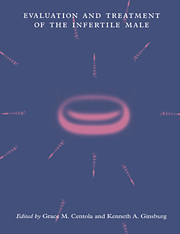Book contents
- Frontmatter
- Contents
- Preface
- List of contributors
- 1 Andrology
- 2 Sperm–egg interaction
- 3 Routine semen analysis
- 4 Computer-aided sperm analysis: a critical review
- 5 Antisperm antibodies: diagnosis and treatment
- 6 The sperm penetration assay
- 7 Intrauterine insemination for male factor
- 8 Processing human semen for insemination: comparison of methods
- 9 New assays for evaluating sperm function
- 10 Assisted reproductive technology for male factor infertility
- 11 Microinjection techniques for male infertility
- 12 Therapeutic donor insemination: screening, indications and technique
- 13 Endocrine assessment and hormone treatment of the infertile male
- 14 The urologic evaluation of the infertile male
- 15 Azoospermia: the diagnosis and treatment
- 16 White blood cells in semen and their impact on fertility
- 17 Psychological aspects of male infertility: lifting the shroud of shame
- 18 Evaluation of the female partner
- Index
10 - Assisted reproductive technology for male factor infertility
Published online by Cambridge University Press: 16 September 2009
- Frontmatter
- Contents
- Preface
- List of contributors
- 1 Andrology
- 2 Sperm–egg interaction
- 3 Routine semen analysis
- 4 Computer-aided sperm analysis: a critical review
- 5 Antisperm antibodies: diagnosis and treatment
- 6 The sperm penetration assay
- 7 Intrauterine insemination for male factor
- 8 Processing human semen for insemination: comparison of methods
- 9 New assays for evaluating sperm function
- 10 Assisted reproductive technology for male factor infertility
- 11 Microinjection techniques for male infertility
- 12 Therapeutic donor insemination: screening, indications and technique
- 13 Endocrine assessment and hormone treatment of the infertile male
- 14 The urologic evaluation of the infertile male
- 15 Azoospermia: the diagnosis and treatment
- 16 White blood cells in semen and their impact on fertility
- 17 Psychological aspects of male infertility: lifting the shroud of shame
- 18 Evaluation of the female partner
- Index
Summary
Introduction
The standard in vitro fertilization (IVF) procedure was originally developed to treat infertility secondary to irreparable tubal factor. It soon became clear, however, that couples with infertility on the basis of other factors, including those with an apparent male factor, might benefit from IVF (Mahadevan et al., 1983; Battin et al., 1985; Cohen et al., 1985) or other assisted reproductive technology (ART) procedures requiring oocyte retrieval such as gamete intrafallopian transfer (GIFT) (Matson et al., 1987). This chapter provides an overview of the use of ART for male factor infertility. The emphasis will be on IVF. Many of the topics covered are reviewed in greater detail in other chapters, and in particular the assisted fertilization techniques are described in Chapter 11.
Current application of ART to male factor infertility
The term ART in its broader sense encompasses a large number of fertility enhancing processes, including not only techniques requiring oocyte retrieval but also less involved techniques such as intrauterine insemination (IUI) (Brown & Lavy, 1992). All these have been applied to cases of male factor infertility. They differ substantially in terms of their overall complexity, laboratory requirements, invasiveness and cost.
Often ART techniques can be applied to cases of male factor infertility even when the precise nature of the underlying problem is not understood. ART techniques have also been increasingly applied to less common male factor cases such as obstructive azoospermia secondary to failed vasovasostomy or congenital absence of the vas deferens (Silber et al., 1988; Bennett, 1990), and ejaculatory failure secondary to spinal cord injury, diabetes mellitus or other conditions (Bennett, 1990; Rainsbury, 1992).
- Type
- Chapter
- Information
- Evaluation and Treatment of the Infertile Male , pp. 130 - 155Publisher: Cambridge University PressPrint publication year: 1996
- 1
- Cited by



